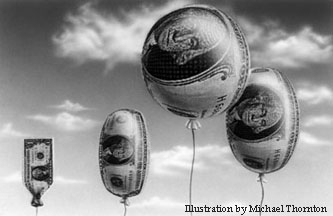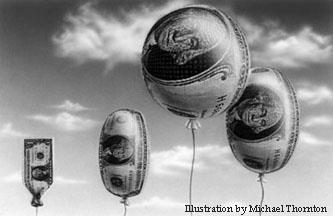- Budget & Spending
- Economics
- Monetary Policy
Prisoners of Faulty Statistics

Just as subatomic particles are the basic building blocks of physics, so prices and quantities are the fundamental building blocks of the economy, the foundation on which all analysis, theory, measurement, and policy rests. If prices or their rate of change, inflation, are not measured accurately, there will be cracks in the foundation. We will be prisoners of faulty statistics.
But measuring inflation accurately is central to almost every economic issue, from monetary policy to measuring economic progress to the cost and structure of indexed spending and taxes. Many private contracts, including the forthcoming indexed Treasury bonds, are explicitly tied to the consumer price index (CPI), and an even larger number calibrate informally. Financial markets price expected future inflation into asset prices. About one-third of federal budget outlays are annually automatically escalated by the change in the CPI, as are income tax brackets (but unfortunately not the definition of income).
Last winter, the Congressional Advisory Commission on the Consumer Price Index, which I chair, released its final report. My four eminent economist colleagues and I concluded that changes in the CPI currently overstate the change in the cost of living by about 1.1 percentage points a year. That is, if inflation as measured by the percentage change in the CPI is running 3 percent, the true change in the cost of living is about 2 percent. This bias might seem small. But when compounded over time, the implications are enormous. For example, over a dozen years, the cumulative additional national debt from overindexing the budget would amount to $1 trillion! Just the additional overindexing would be the fourth-largest program in the federal budget, after only Social Security, health care, and defense.
The implications of overstating inflation for understanding economic progress are equally striking. Instead of falling by 13 percent, real hourly earnings have risen by 13 percent from 1973 to 1995. Certainly there has been a slowdown in wage growth, reflecting the productivity slowdown, but not a decline. Real median family income over the same period grew 36 percent, not the puny 4 percent in the official statistics that deflate by the CPI. The CPI component price indexes are also used as input into the national income accounts (NIA). Although the Commerce Department's NIA methodology reduces the bias from the CPI, much remains, and thus our measures of real economic growth and productivity gains are also understated substantially, by perhaps three-quarters of a percentage point a year.
The commission recommended that the president and Congress explicitly decide whether they wish to continue the widespread substantial overindexing in the budget. If the purpose of indexing is a full and accurate insulation from changes in the cost of living, no more and no less, they should pass legislation wholly or partly correcting the problem. We describe several options in the report for doing so.
The Fixed Basket
But why does the CPI overstate actual inflation? The strength of the CPI is the underlying simplicity of its concept: pricing a fixed, but representative, market basket of goods and services over time. Its weakness follows from the same conception: the fixed basket becomes less and less representative over time as consumers respond to price changes and new choices.
Follow the actual behavior of consumers in the economy. Hop into your car and drive to a discount outlet, purchase a VCR for your child's birthday; swing by the supermarket, where the price of beef has gone up substantially, so you buy chicken instead. Return home, defrost the frozen vegetables in the microwave oven, and turn on the television to watch the evening news. In this hour or two that reflects the everyday buying habits of millions of Americans, note the following: you drove on radial tires, which are far safer than bias-ply tires (and which last three to five times longer, thus reducing maintenance costs); the VCR you purchased for $170, which would cost $200 at a local appliance store, has many more features and is far more reliable than the first generation, which cost about $1,000 two decades ago; by substituting chicken, you partially insulate your family from the rise in beef prices; the microwave oven did not exist thirty years ago; and your TV is color, likely to get fifty cable channels, has a much clearer picture, and is much more reliable than TVs were a generation ago (remember home visits from TV repairmen?).
The CPI uses a fixed market basket from 1982 to 1984, so it makes no account whatsoever for substitution among commodities. It prices within outlets, and hence fails to record the shift to lower-price outlets as, at least partly, lowering prices. Many new products are brought into the CPI infrequently, usually at the time of the ten-year revisions; hence, VCRs and microwave ovens first appeared a decade after they were in widespread use and after their prices fell 80 percent or more. This price decline, common in the product cycle, particularly for durable goods, never shows up in the CPI. Despite the efforts of the Bureau of Labor Statistics (BLS) to account for quality changes, it is widely recognized that improvements in safety, durability, and energy efficiency are not fully reflected.
As income grows we demand more quality and convenience, not just more of what we already consume. Technology and entrepreneurship provide it. Last year almost two-fifths of households had personal computers, and about 60 percent had answering machines. Neither product existed in 1970. In the homes of the generation that fought World War II, less than half had central heating or a refrigerator; over half used coal as a household fuel and another quarter used wood; a majority of rural homes did not have running water. Virtually no one had air-conditioning; today, about three out of four Americans have air-conditioned homes. The list of improvements that have transformed home, work, and leisure for the overwhelming majority of Americans goes on and on.
Continual Revision Mode
In the first major external evaluation since the Stigler commission in 1961, our commission recommended that the BLS replace the fixed-weight index with a cost-of-living index taking account of consumer substitution. Other recommendations, such as use of scanner data, would enable the BLS to get new products incorporated more quickly and to adjust more fully for quality change. The overriding theme of these suggestions is for the BLS to be in continual revision mode, rather than organizing itself for major revisions only once every ten or fifteen years.
Some of the commission's recommendations could be implemented quickly with little or no additional costs. Others will require more time and money. Although we have identified some potential areas of savings in our report, and sympathize with the recent trend to try to use private-sector business methods to make the federal government more efficient, we also note that virtually every private enterprise in the country is spending heavily to improve its information technology.
Finally, the consumer price index focuses on the market basket of consumer spending. Government mandates and taxes, now at historical peacetime highs, require "spending" outside the market basket. Nonmarket items that heavily affect the quality of life are generally beyond the current scope of such indexes. The charge often levied-that if such factors were included the standard of living would have gone up much less-simply does not hold water with available information. Objective measures of environmental pollution show substantial improvement over the last quarter century. Although crime is a serious problem, it appears to have declined somewhat in the last few years.
Gain in Life Expectancy
But, surely, swamping virtually everything else is the tremendous gain in life expectancy-an increase of almost five years in the past quarter century. It would be hard to imagine many people trading several years of additional life to go back to the "good old days" to heat their homes with wood and coal.
The commission's recommendations provide the BLS with an historic opportunity to make major improvements in the nation's price statistics and the president and Congress with an opportunity to get indexing right. The current measures are simply not accurate enough.
















